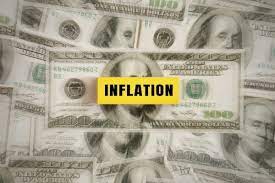Inflation in the United States increased from 3.9 percent in 1970 to 9.7 percent in 1980 and then decreased until it hit a low of 2.9 percent in 2009, according to data from the Bureau of Labor Statistics. Inflation then began to increase again in late 2010, and it has now reached 3.7 percent, which is the highest rate since 2008.
US inflation rose to a 40-year high of 7.9% last month
The US economy has been facing major inflationary pressure in the last few months. According to recent data, inflation rose to a 40-year high of 7.9 last month, far exceeding the expectations of most economists. This is a worrying trend as it could lead to higher prices for consumers and businesses and hinder economic growth.
Experts attribute this rise in inflation to several factors such as supply chain disruptions caused by the pandemic, a surge in demand due to pent-up consumer spending, and rising energy prices. These drivers are expected to continue for some time, making it difficult for policymakers to control inflation without impacting other aspects of the economy.
While some analysts believe that this jump in inflation is temporary and will subside once these factors stabilize, others fear that it could have long-term implications on the economy if not addressed promptly. As businesses struggle with rising costs and consumers face higher prices at stores, policymakers must find ways to curb inflationary pressures while ensuring sustained economic growth.
Rajkotupdates.News: Us Inflation Jumped 7.5 In 40 Years
The recent report on US inflation reveals that it has jumped 7.5 in the last 40 years, which is higher than expected. This increase in the inflation rate affects the overall economy and ultimately impacts every individual’s purchasing power. The high rate of inflation means that people are paying more for goods and services, including housing, healthcare, and education.
The rise in the inflation rate can be attributed to various factors such as increased government spending, rising commodity prices, and a growing population. Higher demand for goods and services coupled with limited supply leads to an increase in prices that contributes to inflation. The Federal Reserve manages monetary policy by controlling the money supply through interest rates, which plays a crucial role in regulating inflation.
In conclusion, the rise in US inflation emphasizes the importance of monitoring economic indicators closely to mitigate its impact on individuals’ financial well-being. As businesses continue to adjust their operations amid this economic environment, being informed about market trends becomes increasingly critical for consumers looking to make sound financial decisions.
Prices had risen seven percent over the course of 2021
The rising prices of goods and services have been a growing concern for many Americans this year. According to recent reports, the inflation rate has reached 7.5 percent in the United States, which is the highest it’s been in over four decades. This rise in inflation has caused prices to increase by seven percent over the course of 2021 alone.
Many factors have contributed to this increase, including supply chain disruptions caused by COVID-19 and increased consumer demand as more people return to pre-pandemic activities. Additionally, there has been significant government spending on relief packages and infrastructure projects that have injected additional funds into the economy.
As a result of these economic conditions, consumers are feeling the pinch when it comes to everyday purchases such as groceries, gas, and housing costs. While some experts predict that inflation will eventually taper off as supply chains stabilize and government stimulus programs wind down, others warn that high levels of inflation could persist for months or even years to come.
In summary, rising prices have become a reality for many Americans in 2021 due to a combination of pandemic-related factors and government spending initiatives. As we move forward into an uncertain economic landscape, it’s important for individuals and businesses alike to carefully consider their financial decisions in order to navigate this challenging environment successfully.
US inflation jumped 7.5 in 40 years Rajkotupdates.news Reason:
The US economy has experienced a significant increase in inflation over the last 40 years, with the latest figures indicating a jump of 7.5%. This has been attributed to several factors, including rising energy costs and an increase in food prices. In addition, the COVID-19 pandemic has had a significant impact on inflation rates worldwide.
As consumers continue to feel the effects of rising prices, businesses are finding it increasingly challenging to balance their budgets. Some have responded by increasing their prices or cutting back on expenses wherever possible, while others have focused on improving productivity and efficiency to keep costs under control.
The Federal Reserve is closely monitoring this situation and has implemented policies aimed at stabilizing inflation rates. However, it remains to be seen whether these measures will be effective in keeping inflation within manageable levels over the long term. Ultimately, only time will tell how this trend will continue to evolve in the coming years.
What caused the inflation?
The factors that caused inflation over the last 40 years are complex and multifaceted. One of the biggest culprits is the growing money supply, which has outpaced economic growth. This phenomenon results in too much money chasing too few goods, creating upward pressure on prices. Additionally, globalisation and the rise of outsourcing have led to an increase in demand for goods and services that cannot be met by domestic suppliers alone, driving up prices.
Another contributor to inflation is government fiscal policy. Large budget deficits financed through borrowing can cause inflation because they result in more money being injected into the economy without a corresponding increase in output. Inflation expectations can also play a significant role in driving up prices since businesses may raise prices if they believe that inflation will persist beyond a specific period.
Ultimately, there is no single cause of inflation, but rather multiple factors at play. Tackling it requires policymakers to carefully balance monetary and fiscal policies while keeping an eye on broader macroeconomic trends such as economic growth and consumer demand.
How has inflation affected everyday lives?
It’s no secret that the rising cost of living is affecting many people across the United States. Inflation, which refers to the increase in prices of goods and services over time, has not only affected household budgets but also businesses and government agencies. The impact of inflation on everyday life can be seen in various ways, such as reduced purchasing power, increased borrowing costs, and decreased standards of living.
One way inflation affects everyday life is through reduced purchasing power. As prices for basic necessities like food and housing rise steadily, people are forced to spend more money on these items alone, leaving less disposable income for other expenses. This means that consumers have less ability to make discretionary purchases or save for future goals like retirement or education expenses.
Inflation also impacts borrowing costs since lenders must charge higher interest rates to account for the declining value of money over time. This makes it more difficult for individuals and businesses alike to access credit at affordable rates leading to a decrease in investment opportunities or business expansion plans. Overall, inflation affects everyone by reducing their buying power while increasing stress on budgets limiting individuals from meeting financial goals as easily.
How does inflation compare to other economic indicators?
Inflation is one of the most significant economic indicators, and it measures the overall rise in prices of goods and services over some time. While inflation can be a sign of a growing economy, too much inflation can lead to decreased consumer confidence and purchasing power. The other economic indicators that are widely used include gross domestic product (GDP), unemployment rate, consumer price index (CPI), and interest rates.
Gross domestic product (GDP) represents the total value of goods and services produced by a country’s economy over a specific period. It is used to measure the strength or weakness of an economy. Unemployment rate refers to the percentage of people who are actively seeking employment but unable to find one. A high unemployment rate is an indication that businesses are not hiring while low unemployment is indicative that companies are expanding, creating more job opportunities.
Consumer price index (CPI) measures changes in prices paid for goods and services by households; it’s used as an indicator of inflationary pressures on consumers’ pocketbooks. Finally, interest rates indicate how much borrowers must pay lenders for borrowing money; they affect everything from mortgage rates to loan repayments on credit cards. All these economic indicators work together, making it crucial for policymakers to keep track of them all when making decisions about monetary policy that will impact individuals at every level from business owners down to consumers themselves.
Conclusion
In conclusion, the staggering increase in inflation rates over the past 40 years is a cause for concern. With a jump of 7.5%, it is clear that basic necessities such as food, housing and healthcare are becoming increasingly expensive for Americans. This has led to many families struggling to make ends meet, especially those in low-income brackets.
Furthermore, high inflation rates can also have severe effects on the economy as a whole. It can lead to decreased investment opportunities and increased borrowing costs which ultimately hinder economic growth. Therefore, it is essential for policymakers and economists to address this issue by implementing strategies that ensure stable prices while promoting economic growth.
In summary, while inflation may seem like an abstract concept to some, its impact on daily life cannot be ignored. It poses serious challenges not only on individuals but also on businesses and the economy as a whole. Thus, measures must be taken to mitigate its effects and create a stable financial future for all Americans.















